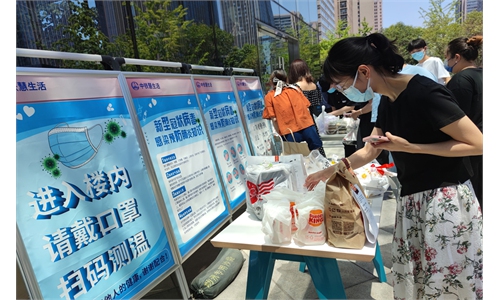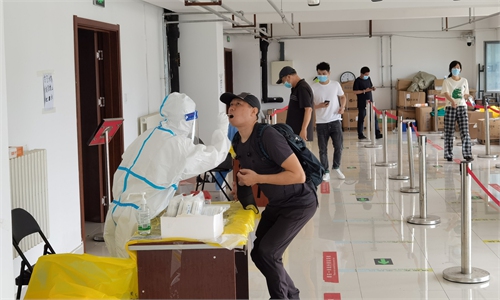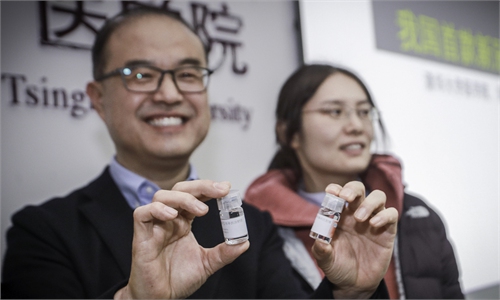China’s CDC head calls for updated booster vaccines as contagious BA.5.2 found in at least four cities

An elderly woman receives COVID-19 vaccine booster in Shanghai. Photo: VCG
The head of the Chinese Center for Disease Control and Prevention Gao Fu has called for the development of updated vaccines as boosters to fight against possible future epidemic subvariants as highly transmissible BA.5.2 has been reported in at least four cities across the nation.
He made the suggestion as a newly research conducted by his team found that the antibody titers in individuals who had received any of the three China-developed inactivated vaccines, were significantly lower against some tested Omicron subvariants in comparison to their corresponding titers against a prototype (PT) strain.
The decreases in neutralizing titers found in the study, were associated with mutations in the spike proteins, read a paper on the research that was published on The New England Journal of Medicine online on July 9.
In this study, the researchers used a pseudovirus to assess the neutralizing antibody titers in serum samples obtained from vaccines against the SARS-CoV-2 PT strain and against omicron subvariants BA.1, BA.1.1, BA.2, BA.2.12.1, BA.3, BA.4, and BA.5. The participant vaccines had received three doses of one of two inactivated virus vaccines (CoronaVac and BBIBP-CorV), which are widely used in China, three doses of the protein-subunit vaccine ZF2001, or two doses of CoronaVac boosted by ZF2001, according to the paper.
The research also found that, in each of the vaccinated groups, the neutralizing antibody titers against BA.4 and BA.5, the subvariants that are currently dominant in South Africa and that have the potential to be the next pandemic subvariants worldwide, were lower by a factor of 2.1 - 2.6 than titers against the BA.2 subvariant.
This finding indicated that two mutations (L452R and F486V) in the receptor-binding domain (RBD), as compared with the RBD in the BA.2 subvariant, resulted in lower antibody neutralization efficiency elicited by current vaccines designed on the basis of the PT sequence, read the paper.
The research also found that the number of antibodies increased with the increasing interval between the second and third doses, especially against the Omicron subvariants.
In vaccines who had left an interval of 4 to 6 months between the second and third doses, neutralizing antibody titers were higher by nearly a factor of 10 against the PT isolate and by a factor of approximately 30 against all Omicron subvariants, as compared with vaccines who had waited for only a one-month interval between doses.
The group of participants who had taken a different kind of vaccine as a booster than the one they had previously received showed higher neutralizing antibody titers against the PT isolate and all Omicron subvariants than the group of participants who had received three doses of the same inactivated vaccine. However, the factor reductions in the response against the BA.2, BA.2.12.1, BA.4, and BA.5 subvariants as compared with the response against the PT isolate were greater in the heterologous-boosted group than in the inactivated-vaccine group, according to the paper.
Gao called for the development of updated vaccines as boosters in order to provide better protection against current subvariants (especially BA.4 and BA.5) and possible future epidemic subvariants.
According to the Chinese National Health Commission, a total of 65 domestic confirmed cases and 279 domestic asymptomatic virus carriers were reported on the Chinese mainland on Saturday.
The BA.5 subvariant, which Chinese academician Zhang Boli said is believed to be the most contagious strain known so far, has also been discovered on the mainland in May.
This month, infection cases caused by BA.5.2 strain had been reported for the first time on the Chinese mainland in Xi'an in Northwest China's Shaanxi Province and then in Beijing.
Zhang told media that the BA.5.2 infections in Xi'an had lead to the strictest anti-epidemic measures this year. In response, he suggested the distribution of COVID-19 antigen testing kits and further promotion of vaccination among the elderly group.
Besides Xi'an and Beijing, infections caused by the BA.5.2 strain have been found in Tianjin and Shanghai. A Shanghai health official said at a press conference on Sunday that gene sequencing showed that an infection discovered on Friday was caused by BA.5.2 and related to a previous imported case.
Chinese manufacturers are accelerating efforts to update or develop new-generation vaccines and drugs amid mutating virus.
Jiangsu Simcere Pharmaceutical Group told the Global Times in recent interview that it had been closely following the mutations of the virus and its COVID-19 prevention medicine, which is under Phase II clinical trials in Shanghai, is designed to deal with various mutations.
A China-developed neutralizing antibody combination COVID-19 therapy, jointly developed by Tsinghua University, the Third People's Hospital of Shenzhen and Brii Biosciences, has shown effectiveness against BA.4 and BA.5 in recent studies, researchers said at a press conference on Friday.
China National Pharmaceutical Group (Sinopharm) announced on Saturday that an Omicron-specific inactivated vaccine developed by an institute under its subsidiary China National Biotec Group (CNBG) had been approved for clinical trials by national authorities.
In May, clinical trials on another Omicron-specific inactivated vaccine developed by CNBG's Beijing research institute had already kicked off.
Chinese vaccine developer CanSinoBIO announced that its COVID-19 mRNA vaccine has received approval for clinical trials in China. Sinopharm also said its second-generation recombinant protein COVID-19 vaccine had received approval for clinical trials.



